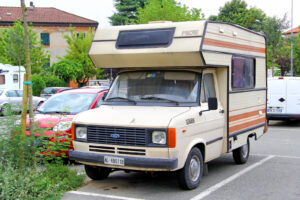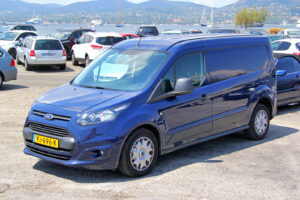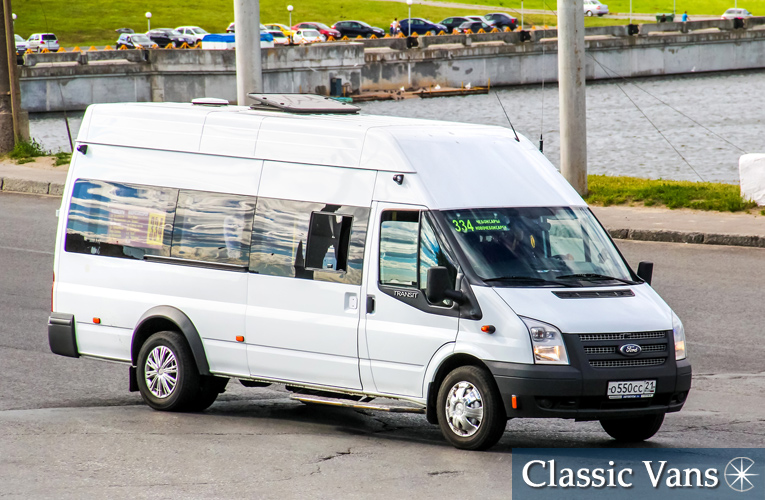Everything you need to know about the Ford’s classic Transit series of custom vans
Throughout the decades, the Ford Transit has undergone many transformations and upgrades, but underpinning it all is 4 basic platforms (or chassis). Since first going on the market, more than 8 million Transits have been sold, cementing its status as the third best-selling van of all time.
Continue reading to learn more about the history of the Transit and more.
Ford Transit history
Ford’s earliest vans can trace their roots back to just after World War II, when the first production of vehicles to carry the Transit badge was built at Ford’s Cologne, Germany plant as a joint British-German venture.
Beginning in 1953, the Ford Taunus Transit van was unveiled with a 1,000-kilo cargo capacity and powered with a 1.2-liter engine, which was enlarged to 1.5 liters in 1955. This early forerunner to the Transit van we know today ceased production in 1965, when Ford released a redesigned van with increased capacity that was originally targeted to the European market only.
While most Americans are familiar with Ford’s Econoline-series of vans, built on the F-150 chassis, much of the world knew the Transit as the primary van made by Ford. The Transit wasn’t sold in America until its fourth generation, beginning in 2013. The 2014 Transit was co-designed by engineering teams in both North America and Europe.


Also beginning in 2013, Ford started manufacturing a medium-sized van that’s smaller than the standard Transit, but bigger than their Transit Connect called the “Transit Custom.” However, this model is not yet for sale in the United States or Canada. But it is sold in Mexico.
Ford Transit features, trims and specifications
Following the New Edge styling of the Transit van, Ford decided to shift the design to follow the Kinetic design language and the interior of the modern Transit was inspired by the third-generation Ford Focus. The van can be ordered with 3 different roof and sliding door heights. In keeping with Ford’s truck marketing, the Transit has XL and XLT trims and 150/250/350 payload capabilities, which are determined by body length, wheelbase and roof height.
Engines currently offered in the Transit consist of a 185 hp, 3.2L inline-5 Duratorq diesel and 3.5L twin-turbo 310 hp V6—all mated to a 6-speed automatic transmission. The 6-speed auto was replaced with a 10-speed unit in 2020 models.
The fourth-generation Transit comes standard with rear-wheel drive and 2 wheelbases: 130 inches and 147.6 inches. A chassis cab/cutaway van is also available with a 178-inch wheelbase and either single or dual rear-wheel axles.
Unlike the previous Econoline vans, the Transit is built with unibody construction instead of on frame rails. The Transit’s live rear axle is held in place via leaf-springs and MacPherson struts are used on the front end.
The Transit is capable of towing up to 7,500 lbs and handles a payload of up to 4,500 lbs. Transits come with a 25-gallon fuel tank and can get up to 15 mpg city/19 mpg highway. Transits also come with 4-wheel disc brakes and standard anti-lock braking system. Factory window tint is also standard.
In addition, new Transits come with safety features like Ford’s Co-Pilot 360 collision assist and lane-keeping/departure warning, low tire pressure warning, dual stage driver and passenger front and side airbags and electronic stability and roll control. Back-up cameras are also standard.
2020 Ford Transit upgrade
The Transit went through a major facelift in 2020, when the dashboard and front fascia were updated. Powertrain options were also updated during this mid-cycle model revision. In North America, a 3.5L 275 hp V6 replaced the 3.7L V6, but Ford’s trusty 3.5L twin-turbo V6 with 310hp was still an option.
Also new for 2020 is the optional all-wheel drive—the first AWD Ford has offered since the late 90s Aerostar. Another feature added to the van are power-sliding doors, dual sliding doors and crew-cab (or double-cab) configuration to seat 5 and still retain lots of rear cargo space.
Ford Transit uses and applications
In recent decades, the Transit has grown in popularity as:
- Campers and travel vans
- Minibuses and school buses
- Ambulances
- Police and fire vehicles
- Heating, cooling and plumbing companies
- Transportation for large families

Global competitors to the Transit include the Mercedes Sprinter, Fiat Ducato, Chevrolet Express/GMC Savana and Volkswagen Crafter.
Fun facts about the Ford Transit
- Every year since 2014, more than 115,000 Transits have been sold in the U.S., with more than 150,000 sold in 2019.
- The original idea for the Transit originated from Henry Ford Jr., who in the 1950s proclaimed that the company would build “one van for Europe” and that set the tone for all the research and engineering that went into creating the van.
- The average yearly mileage racked up on a Ford Transit in Europe is about 25,000 miles. There are many examples of the vans going 600,000+ miles on original motors. One diesel Transit owner in Pilsen, Czech Republic, racked up 999,999 km when his odometer stopped working. Ford installed a second one to keep tracking miles.
- Many of the Transit’s parts are designed to have a lifetime operation of 300,000+ miles, longer than many other van maker’s parts.
- The Transit was the first vehicle to have a 5,000-mile service interval.
- The first Transit rolled off a Berkshire, England assembly line in August 1965 with a base price of about $1,000 (equivalent to about $8,304.19 today). A 15-seat version cost double that, but one college near London managed to cram a record-breaking 48 people into it! (For safety reasons, we don’t recommend trying to break this record.)
- In the 1970s, London Metro Police and Scotland Yard estimated that 95% of bank robberies were conducted with a Transit as the getaway vehicle due to their commonality, decent performance and room for almost 2 tons of passengers (and money).
- On at least 3 occasions, Ford installed high-output racing V8s and a Grand Prix racing engine into Transit vans to set speed records, with one clocking 174 mph at the Silverstone race track in the U.K. That same Transit was then used to tow a travel trailer to a record 170 mph.
- The fourth generation Transit (2013 and newer), is built at 4 different locations around the globe: Nanchang, China; Yelabuga, Russia; Kocaeli, Turkey; and Claycomo, Missouri.
- During testing of the fourth generation Transit, Ford drove pre-production models the equivalent of 7 million miles—or about 275 times around the globe—and tasked the vans with driving in extreme conditions in Finland’s arctic region and California’s Death Valley.
Ford Transit awards and accolades
The Transit has won dozens of awards and acolytes over the years, including “International Van of The Year” in 2001, 2003, 2007, 2013, 2014 and 2020—more than any other manufacturer. The Transit has also been featured on lists such as “Best Pre-Owned Vehicles That Hold Their Value” and “Best Fleet Value.”
Where to buy new and used Ford Transits for sale?
Here at Classic Vans, we’ve been selling new and used Transit vans since they first became available in America. We often have 7-and 9-passenger vans in stock, with features like interior LED lighting, wood trim, alloy wheels, power rear sofa, flatscreen LED television with DVD and gaming connections, heated seats, USB power and moonroof. We also have Ford Transit-based class B RVs and motorhomes in stock from time to time.
Whatever your van desires are, Classic Vans is bound to have a rig in stock that can provide the quality and convenience you expect from your vehicles. Contact us to schedule a time to walk our lot and test drive a new or used van today.
Don’t live in California? No problem! Ask about our low-cost nationwide van delivery service.
New and Used Ford Transit for Sale
Don’t see what you’re looking for? Our new van inventory is queuing up to be displayed online. Just give us a quick call or contact us and we’ll connect you to your perfect vehicle.
Verified Customer





